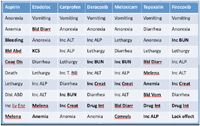NSAIDs: Myths, magic and realities (Proceedings)
For many years, chronic pain in dogs and cats was either tolerated as a necessary evil, or was considered a reason for euthanasia to relieve the pet from unnecessary suffering.
For many years, chronic pain in dogs and cats was either tolerated as a necessary evil, or was considered a reason for euthanasia to relieve the pet from unnecessary suffering. With the development of contemporary pharmaceuticals and technology, more pets are able to live reasonably comfortable lives despite chronic conditions that could have previously caused unrelieved suffering. Chronic pain should be treated with a similar approach as acute pain, utilizing multimodal therapy. Multimodal therapy encompasses not only drugs which act at various levels of the nociceptive pathways, but in the case of osteoarthritis, multiple non-drug therapies also. Because osteoarthritis is the most common chronic painful problem in dogs and cats, this session will concentrate on the management of chronic pain with the emphasis on osteoarthritis.
Osteoarthritis (OA) is the most common orthopedic problem in dogs and cats, encompassing about 20% of the population across all age ranges. The incidence increases with age. The multimodal approach to pain control for patients with OA includes weight loss, controlled exercise, pain relieving drugs such as nonsteroidal anti-inflammatory drugs, corticosteroids, opioids, and, NMDA antagonists, oral and injectable chondroprotective drugs, massage, acupuncture, low level laser therapy, physical rehabilitation, nutrition, and surgical intervention. Not all aspects of multimodal therapy can be covered in this one session. This section will concentrate on NSAID therapy.
Nonsteroidal anti-inflammatory drug (NSAID) administration has become very common in small animal practice, especially with dogs. There are six approved NSAIDs for use in dogs: etodolac, carprofen, deracoxib, tepoxalin, meloxicam, and firocoxib. Both carprofen and meloxicam are available in injectable formulations and can be given perioperatively. Deracoxib and carprofen are also approved for perioperative oral dosing for acute pain control. The NSAIDs have multiple mechanisms of action. Inhibition of the cyclo-oxygenase 2 enzyme is the predominant mechanism for pain control for all the drugs except tepoxalin which also has activity at inhibiting the 5-lipoxygenase enzyme. NSAID therapy should be avoided in patients with a current history of liver disease, kidney disease, vomiting, diarrhea, dehydration, shock, and coagulopathies.
Before administering an NSAID on a long-term basis, a blood chemistry profile should be assessed as baseline data. While there are no clear cut recommendations of retesting, one author believes dogs should be tested 2-3 weeks after initiating treatment and every 6-12 months thereafter. If patients develop any illness that might be related to, or exacerbated by, NSAID therapy, NSAID administration should be discontinued and a blood chemistry profile reassessed.

Table 1. Top 10 Reported Side Effects to the US Food and Drug Administration of the Six Approved NSAIDs in Dogs Plus Aspirin as of April 8, 2009.
There is little information on comparisons between NSAIDs, however it is likely that, as in human medicine, no differences in efficacy between the agents would be found. When differences are found, they are frequently clinically irrelevant with a difference at one time period over multiple days. However, individual dogs may appear to do better with one NSAID compared to another. This is not due to inherent differences in efficacy between the various NSAIDs; rather it is due to the individual response of that animal. Likewise, one NSAID may produce an adverse response in an animal, but another NSAID does not.
While there are virtually no differences in overall pain control between NSAIDs, there may be differences in side effect profiles. This may be largely related to the mechanism of action. Relative COX-1 sparing drugs such as carprofen may have a different set of side effects compared to coxib class NSAIDs such as deracoxib or a duel inhibitor such as tepoxalin. The ten most reported side effects to the Food and Drug Administration are listed in Table 1. This source of data drives the important concept of veterinary professionals reporting side effects as they occur in individual practices.
Podcast CE: A Surgeon’s Perspective on Current Trends for the Management of Osteoarthritis, Part 1
May 17th 2024David L. Dycus, DVM, MS, CCRP, DACVS joins Adam Christman, DVM, MBA, to discuss a proactive approach to the diagnosis of osteoarthritis and the best tools for general practice.
Listen